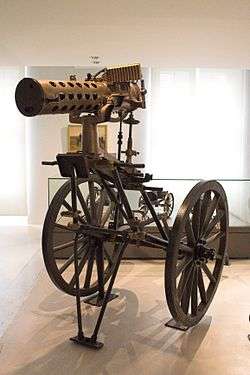Chassepot
| Chassepot | |
|---|---|
 Chassepot rifle with bayonet | |
| Type | Needle gun |
| Place of origin | France |
| Service history | |
| In service | 1866–1874 |
| Used by |
France Monaco Qajar Dynasty Greece |
| Wars |
French colonial conflicts, Franco-Prussian War, other conflicts |
| Production history | |
| Designer | Antoine Alphonse Chassepot |
| Designed | 1858–1866 |
| Produced | 1866–1875 |
| No. built | ~2,000,000 |
| Specifications | |
| Weight | 4.635 kilograms (10 lb 3.5 oz) |
| Length |
1.31 m (without bayonet) 1.88 m (6 ft 2 in) (with bayonet) |
| Barrel length | 795 mm (31.3 in) |
|
| |
| Cartridge |
Lead bullet 25 g (386 grains) in paper cartridge charge 5.6g (86.4 grains) black powder |
| Caliber | 11 mm (.433 inches) |
| Action | Bolt action |
| Rate of fire | 8-15 rounds per minute |
| Muzzle velocity | 410 m/s (1345 ft/s)[1] |
| Effective firing range | 1,200 m (1,300 yd) |
| Feed system | Single-shot |
| Sights | Ladder |
The Chassepot, officially known as Fusil modèle 1866, was a bolt action military breechloading rifle, famous as the arm of the French forces in the Franco-Prussian War of 1870/1871. It replaced an assortment of Minié muzzleloading rifles many of which were converted in 1867 to breech loading (the Tabatière rifles). A great improvement to existing military rifles in 1866, the Chassepot marked the commencement of the era of modern bolt action, breech-loading, military rifles. Beginning in 1874, the rifle was easily converted to fire metallic cartridges (under the name of Gras rifle), a step which would have been impossible to achieve with the Dreyse needle rifle.[2]
It was manufactured by MAS (Manufacture d'armes de Saint-Étienne), Manufacture d'Armes de Châtellerault (MAC), Manufacture d'Armes de Tulle (MAT) and, until 1870, in the Manufacture d'Armes de Mutzig in the former Château des Rohan. Many were also manufactured under contract in England (the "Potts et Hunts" Chassepots delivered to the French Navy), in Belgium (Liege), and in Italy at Brescia (by "Glisenti"). The approximate number of Chassepot rifles available to the French Army in July 1870 was 1,037,555 units.[3] Additionally, State manufactories could deliver 30,000 new rifles monthly. Gun manufacturers in England and Austria also produced Chassepot rifles to support the French war effort. The Steyr armory in Austria delivered 12,000 Chassepot carbines and 100,000 parts to France in 1871.[4] Manufacturing of the Chassepot rifle ended in February 1875, four years after the end of the Franco-Prussian War, with approximately 700,000 more Chassepot rifles made between September 1871 and July 1874.[5]
History
The Chassepot was named after its inventor, Antoine Alphonse Chassepot (1833–1905), who, from the mid-1850s onwards, had constructed various experimental forms of breechloaders.[6][7] The first two models of the Chassepot still used percussion cap ignition. The third model, using a similar system to the prussian Dreyse needle gun, became the French service weapon in 1866. In the following year it made its first appearance on the battlefield at Mentana on 3 November 1867, where it inflicted severe losses upon Giuseppe Garibaldi's troops. It was reported at the French Parliament that "Les Chassepots ont fait merveille!", or loosely translated: "The Chassepots have done wonderfully!" The heavy cylindrical lead bullets fired at high velocity by the Chassepot rifle inflicted wounds that were even worse than those of the earlier Minié rifle. By 1868, the entire French active army had been re-armed with the Chassepot.
In the Franco-Prussian War (1870/1871), the Chassepot met its Prussian counterpart, the Dreyse needle-fire rifle. The Chassepot had several advantages over the Dreyse. It featured a rubber obturator on its bolt head to provide a more efficient gas-seal. Although it fired a smaller caliber (11 mm vs. 15.4 for the Dreyse), the Chassepot ammunition had more gunpowder (5.68 grams vs 4.85 grams), resulting in higher muzzle velocity (436 meters per second, 33% over the Dreyse), a flatter trajectory and a longer range. Thus the sights on the Chassepot could be elevated up to 1,600 meters, while the maximum sight setting of the Dreyse was only 600 meters.[8] The Chassepots were responsible for most of the Prussian and other German casualties during the conflict. After the war, 20,000 captured Chassepot rifles were sold to the Shah of the Persian Qajar Dynasty.
Technology
Bolt mechanism
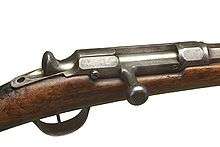
The breech was closed by a bolt similar to those of more modern rifles to follow. Amongst the technical features of interest introduced in 1866 on the Chassepot rifle was the method of obturation of the bolt by a segmented rubber ring which expanded under gas pressure and thus sealed the breech when the shot was fired. This simple yet effective technology was successfully adapted to artillery in 1877 by Colonel de Bange, who invented grease-impregnated asbestos pads to seal the breech of his new cannons (the De Bange system).
Cartridge
The Chassepot used a paper cartridge, that many refer to as being 'combustible', whereas in reality it was quite the opposite. It held an 11mm (.43 inch) round-headed cylindro-conoidal lead bullet that was wax paper patched. An inverted standard percussion cap was at the rear of the paper cartridge and hidden inside. It was fired by the Chassepot's needle (a sharply pointed firing pin) upon pressing the trigger.
While the Chassepot's ballistic performance and firing rates were excellent for the time, burnt paper residues as well as black powder fouling accumulated in the chamber and bolt mechanism after continuous firing. Also, the bolt's rubber obturator eroded in action, although it was easily replaced in the field by infantrymen. The older Dreyse needle gun and its cartridge had been deliberately constructed in a way to minimize those problems but to the detriment of its ballistic properties.
In order to correct this problem the Chassepot was replaced in 1874 by the Gras rifle which used a centerfire drawn brass metallic cartridge. Otherwise, the Gras rifle was basically identical in outward appearance to the Chassepot rifle. Nearly all rifles of the older Chassepot model (Mle 1866) remaining in store were eventually converted to take the 11mm Gras metallic cartridge ammunition (fusil Modèle 1866/74). About 665.327[5][9] Chassepot rifles had been captured by the German coalition that defeated France in 1871. Large numbers of these captured Chassepot rifles were converted to 11 mm Mauser metallic cartridge and shortened to carbine size in order to serve with German cavalry and artillery until the early 1880s. Others were disposed of "as is" with British surplus dealers. In most but not all cases, the French receiver markings on these German-captured Chassepot rifles had been erased.
Gallery
- Chassepot paper cartridge and boxes.
 French soldier with Chassepot rifle.
French soldier with Chassepot rifle.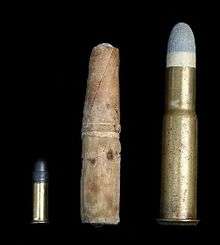 From left: .22 Long Rifle;
From left: .22 Long Rifle;
11mm paper cartridge for Chassepot/Fusil modèle 1866;
11mm×59.5R metallic cartridge for Fusil Gras mle 1874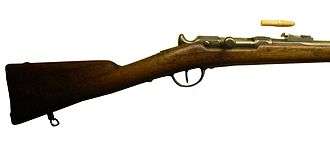 Close-up, with cartridge
Close-up, with cartridge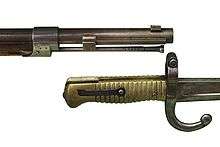 Bayonet assembly
Bayonet assembly 1867 newspaper illustration including a cross-section
1867 newspaper illustration including a cross-section Chassepot gun, model 1866, Mutzig, 1869.
Chassepot gun, model 1866, Mutzig, 1869.
See also
Notes
- ↑ Ford, p. 23
- ↑ New International Encyclopedia
- ↑ Walter, John (25 March 2006). "Rifles of the World". Krause Publications. Retrieved 8 July 2018 – via Google Books.
- ↑ "Zuendnadelgewehr Chassepot". Schmids-zuendnadelseite.de. Retrieved 8 July 2018.
- 1 2 "Bladstadt" (PDF). Bibliotekacyfrowa.pl (in (in Polish)). 1873. Retrieved 8 July 2018.
- ↑ "mousqueton". Alienor.org. Retrieved 8 July 2018.
- ↑ "CMPC Dossiers : De la bouche à la culasse". Alienor.org. Retrieved 8 July 2018.
- ↑ Flatnes, Oyvind (30 November 2013). "From Musket to Metallic Cartridge: A Practical History of Black Powder Firearms". Crowood. Retrieved 8 July 2018 – via Google Books.
- ↑ Walter, John (25 March 2006). "Rifles of the World". Krause Publications. Retrieved 8 July 2018 – via Google Books.
References
- Ford, Roger. The World's Great Rifles London: Brown Books, 1998. ISBN 1-897884-33-8.

External links
| Wikimedia Commons has media related to Chassepot Mle 1866. |
| Preceded by Tabatière rifle |
French Army rifle 1866–1874 |
Succeeded by Fusil Gras Modèle 1874 |
